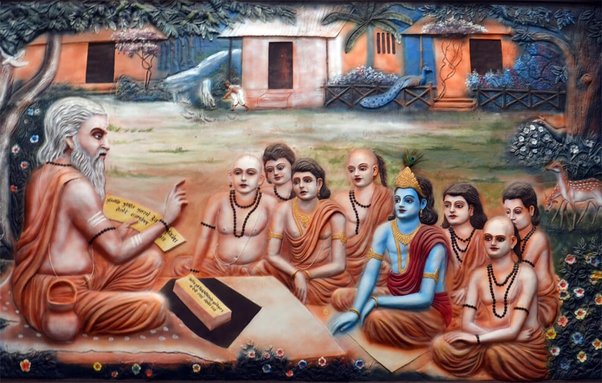
In ancient India, the Sanatana society placed a high value on knowledge and wisdom, and the education process was seen as a path to enlightenment and self-realization. The traditional method of transmitting knowledge was through the Guru-shishya relationship, where the Guru imparted knowledge and guidance to the student through personal instruction and example. This experiential based teaching method was unique to each student and was tailored according to their unique learning capacity.
One of the key advantages of this ancient education system is that it emphasized the development of all the faculties of a human being, rather than just the acquisition of knowledge. The Guru was not only considered to be an Enlightened being but also a Spiritual Guide, this is why the student was expected to have faith in the Guru and to be willing to learn through the Guru’s guidance. Through this holistic education system Guru not only imparted knowledge but also guided the students towards personal development and spiritual growth.
Recent research in education has shown that this holistic approach to education has a number of benefits. Studies have found that students who are taught through experiential learning methods have improved critical thinking skills and problem-solving abilities (1, 2). Additionally, students who are taught through hands-on, interactive methods have been shown to have better retention of information and a deeper understanding of the material being taught (3).
In contrast, the modern education system is heavily focused on rote learning or “book learning”, which relies primarily on written materials, such as textbooks and notes, to transmit information to students. This process focuses solely on the memorization of facts and information, and the ability to recall this information accurately. This method of teaching prioritizes the student’s ability to memorize and recall information, rather than on the holistic development of the student. Furthermore, the rote learning system is often seen as a more passive form of learning, and it is less effective in teaching skills such as critical thinking, problem-solving, and creativity.
Another benefit of the Guru-shishya relationship approach is that it allows for a more customized and tailored instruction, which is more effective for the student. Research has shown that personalized instruction can lead to improved academic performance and increased student engagement (4). Furthermore, the spiritual guidance provided by the Guru in the Sanatana society education system can also have a positive impact on the student’s overall well-being and development. Studies have found that the integration of spiritual practices and values into education can lead to improved emotional regulation and self-esteem (5).
In conclusion, the ancient Sanatana education system, with its emphasis on experiential learning, personal instruction, and spiritual guidance, has been shown to be a more effective and holistic approach to education. The Guru-shishya relationship approach allows for a more customized and tailored instruction that is more effective for the student. This holistic approach not only improves critical thinking skills, problem-solving abilities, retention of information, but also emotional regulation, self-esteem and overall well-being.
References: